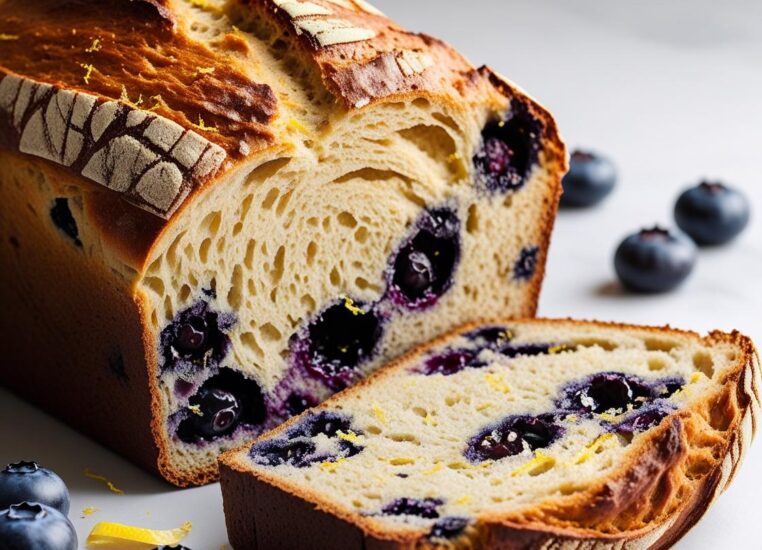I remember the first time I baked a lemon blueberry sourdough.
The smell in my kitchen was amazing!
Making this tasty bread is simpler than you might think.
It adds a tangy twist to traditional sourdough.
It’s great for spring mornings or as a special gift.
Here’s what you’ll need to start: a sourdough starter, fresh or frozen blueberries, and a bit of lemon zest.
The outcome is a moist, flavorful loaf that will wow everyone.
Now, let’s explore the easy steps to make this stunning sourdough bread.
It’s packed with citrus and sweetness.
Lemon Blueberry Sourdough Bread
As a baker, I love sharing the magic of lemon blueberry sourdough bread.
It’s a mix of tangy and sweet, adding a special touch to any meal.
Why This Flavor Combination Works So Well
The lemon and blueberries in sourdough bread are a perfect pair.
The citrus flavor of lemon pairs well with blueberries’ sweetness.
This mix creates a refreshing taste.
The lemon zest’s acidity balances the blueberries’ richness.
This balance makes the flavor complex and interesting.
What Makes This Recipe Special
This lemon blueberry sourdough bread recipe is special because of its unique blend of ingredients.
The lemon zest and juice add a bright, citrusy taste.
Blueberries bring natural sweetness and texture.
This bread is both tasty and beautiful.
It’s great for special occasions or as a gift.
Complete Lemon Blueberry Sourdough Bread Recipe
Now, let’s get into the complete recipe for lemon blueberry sourdough bread.
It’s a mix of tangy lemon and sweet blueberries. It’s perfect for any time of day.
Ingredient List with Measurements
Here’s what you need for this tasty bread:
| Ingredient | Measurement |
|---|---|
| Flour | 500g |
| Water | 350g |
| Sourdough Starter | 150g |
| Salt | 10g |
| Lemon Zest | 1 tbsp |
| Lemon Juice | 2 tbsp |
| Blueberries | 1 cup |
Quick Reference Timeline
Here’s a quick overview of the recipe timeline:
- Mixing: 10 minutes
- Bulk Fermentation: 4 hours
- Proofing: 2 hours
- Baking: 35-40 minutes
Recipe Overview
This recipe starts with mixing the dough.
Then, it goes through bulk fermentation, shaping, proofing, and baking.
The total time is about 7-8 hours. It’s perfect for starting in the morning and enjoying in the evening.
Ingredients Breakdown
To make a great lemon blueberry sourdough, knowing each ingredient’s role is key.
The quality of your ingredients greatly affects the final taste and texture.
Flour Selection and Alternatives
The flour you choose is vital for your sourdough’s texture and taste.
Bread flour is top choice because it has lots of protein.
This helps the dough rise well. But, you can try other flours too:
- All-purpose flour for a lighter texture
- Whole wheat flour for a nuttier flavor and denser texture
- Ancient grain flours for added nutritional value and unique flavors
Choosing the Right Lemons and Blueberries
The freshness and quality of your lemons and blueberries matter a lot.
Choose organic, unwaxed lemons to avoid chemicals.
For blueberries, use fresh or frozen, but make sure they’re good quality.
Other Key Ingredients
Other important ingredients are water, salt, and your sourdough starter. Use filtered or bottled water to help yeast work better. Pick a good salt and make sure your starter is lively and healthy.
- Water: Filtered or bottled
- Salt: High-quality, non-iodized
- Sourdough starter: Healthy, active, and well-maintained
Equipment You’ll Need
The right tools are key to making great sourdough bread.
For a tasty lemon blueberry sourdough, you’ll need a few important items.
Essential Baking Tools
First, you’ll need basic baking tools. These include:
- A mixing bowl: Stainless steel or glass is best for its durability and easy cleaning.
- A dough scraper: This tool is great for scraping dough and folding it during bulk fermentation.
- A baking stone or Dutch oven: These help make your bread’s crust crispy.
Nice-to-Have Equipment
While not necessary, some tools can make baking better:
- A stand mixer: It’s useful for mixing and kneading, perfect for beginners.
- A banneton or proofing basket: These help shape your loaf and add a decorative crust pattern.
- A bench scale: It ensures you measure ingredients accurately, which is vital in bread baking.
Perfection Your Sourdough Starter
To make the perfect lemon blueberry sourdough bread, you need a strong sourdough starter.
This starter is a mix of wild yeast and bacteria.
It ferments the dough’s sugars, creating sourdough’s unique taste and texture.
Signs of a Healthy, Active Starter
A good sourdough starter looks bubbly and frothy, showing it’s fermenting well.
It smells tangy but not too sour, like vinegar.
When you pour it, it should hold its shape a bit, not spread too much.
Key characteristics include:
- Bubbly appearance
- Tangy aroma
- Right consistency
- Doubling in size after feeding
Preparing Your Starter for This Recipe
To get your sourdough starter ready for the lemon blueberry bread, make sure it’s at its best.
Feed it once a day and keep it at room temperature (70-75°F) for the best fermentation.
| Preparation Step | Description | Timing |
|---|---|---|
| Feed Starter | Feed your sourdough starter with equal parts flour and water. | 1-2 days before baking |
| Check Activity | Ensure the starter is bubbly and has doubled in size. | After feeding, before baking |
| Store or Use | Either use the starter immediately or store it in the fridge. | After it’s active and ready |
Creating the Perfect Dough Base
Making the perfect dough base is key for amazing lemon blueberry sourdough bread.
This step involves important techniques that affect the bread’s texture, flavor, and quality.
Autolyse Method for Better Texture
The autolyse method mixes flour and water first, then adds other ingredients.
This step lets flour hydrate fully, making the dough texture even.
Using this method, you get a tender loaf with better crumb structure.

Mixing Techniques for Optimal Gluten Development
Mixing is vital for developing gluten in your sourdough dough.
Gentle folding and resting periods help create a strong, extensible dough.
This method ensures even distribution of ingredients and complex flavors.
When mixing, be gentle to avoid overworking the dough.
Short, intense mixing followed by longer rests is the best approach for perfect gluten development.
Salt Addition Timing
When you add salt affects the bread’s flavor and texture.
Salt added at the right time strengthens the dough and enhances its character.
I add salt during mixing to spread it evenly.
Controlling salt addition timing leads to a balanced flavor and satisfying crumb texture.
Incorporating Lemon and Blueberries
To take your sourdough to the next level, try adding lemon and blueberries.
This mix not only boosts the flavor but also brings a fresh twist to the classic sourdough.
We’ll cover how to make lemon zest and juice, the benefits of using fresh versus frozen blueberries, and the best ways to fold them in.
Preparing the Lemon Zest and Juice
For lemon zest, use a microplane grater to avoid bitterness.
It gives you a fine, fragrant zest without the bitter parts.
Just squeeze the lemon for the juice, straining out any seeds.
Tip: Choose organic lemons to avoid pesticides. Zest the lemon before juicing it.
It’s easier than trying to zest after juicing.
Fresh vs. Frozen Blueberries
Fresh and frozen blueberries both work well in sourdough.
Fresh ones burst with juicy flavor, while frozen ones are less likely to bleed in the dough.
| Blueberry Type | Advantages | Disadvantages |
|---|---|---|
| Fresh Blueberries | Juicy flavor, vibrant color | May bleed into dough, seasonal availability |
| Frozen Blueberries | Less bleeding, available year-round | May be softer, less vibrant color |
Folding Techniques for Even Distribution
To spread lemon zest and blueberries evenly, use gentle folding.
A rubber spatula works well during the bulk fermentation stage.
By mastering these techniques, you’ll make a sourdough bread that’s both flavorful and beautifully balanced with lemon and blueberries.
The Bulk Fermentation Process
Bulk fermentation is where the magic happens in sourdough baking.
It turns simple ingredients into a complex, flavorful loaf.
This process is key for developing the bread’s gluten structure, flavor, and overall character.
Temperature Considerations
The temperature during bulk fermentation greatly affects the fermentation rate and the bread’s flavor.
The ideal temperature is between 75°F to 78°F (24°C to 25°C) for the best results.
Stretch and Fold Schedule
A stretch and fold schedule is important for developing the dough’s gluten structure.
It ensures even fermentation. I usually do a series of stretches and folds every 30 minutes during this phase.
Visual Cues for Proper Fermentation
Watching the dough’s appearance during bulk fermentation gives us clues about its progress.
Look for signs like increased volume, bubbles on the surface, and a more aerated texture.
| Visual Cue | Description |
|---|---|
| Increased Volume | The dough should have expanded and grown in size. |
| Bubbles on Surface | A sign of active fermentation, indicating that the dough is producing carbon dioxide. |
| Aerated Texture | The dough should appear more open and airy, with visible holes and a lighter texture. |
Shaping Your Lemon Blueberry Sourdough Loaf
Getting your sourdough loaf just right is all about mastering pre-shaping and final shaping.
It’s a delicate art that needs patience and practice.
Pre-shaping Techniques
Pre-shaping, or “preshaping,” is the first step in getting your dough ready. It involves:
- Relaxing the dough
- Making sure the ingredients are evenly spread
- Getting the dough ready for its final shape
To pre-shape, gently stretch and fold the dough onto itself.
This makes the dough’s surface smooth and helps it develop its structure.
Final Shaping Methods
Once pre-shaping is done, it’s time for the final shape.
For a round loaf, use a gentle cupping motion to shape it smoothly.
For a batard or oblong shape, stretch and fold the dough to get the right form.

| Technique | Description | Result |
|---|---|---|
| Round Shaping | Gentle cupping motion | Smooth, taut surface |
| Batard Shaping | Stretching and folding | Oblong shape with tension |
Final Proofing Tips and Tricks
As you get close to finishing your bread, the final proofing stage is key.
It lets your lemon blueberry sourdough bread get its final taste and texture before baking.
Using a Banneton or Proofing Basket
A banneton or proofing basket is a great tool for final proofing.
It supports the dough and makes a beautiful, rustic crust.
To use it well, dust it with flour to stop the dough from sticking.
Put your shaped loaf in the basket, seam-side up.
Then, cover it with a cloth or plastic wrap to keep it moist.
Cold Proofing Benefits
Cold proofing, or slowing down the proofing in the fridge, boosts your sourdough’s flavor and texture.
It lets the flavors mix more and helps control the rise.
This makes scoring your bread easier.
To cold proof, put your shaped loaf in the fridge for 8-12 hours or overnight.
Benefits of Cold Proofing:
- Enhanced flavor complexity
- Better control over the rise
- Easier scoring
- Improved texture
| Proofing Method | Temperature | Time | Benefits |
|---|---|---|---|
| Room Temperature Proofing | 75-78°F (24-25°C) | 2-4 hours | Faster proofing, more immediate results |
| Cold Proofing | 39°F (4°C) | 8-12 hours | Enhanced flavor, better texture, easier scoring |
Troubleshooting Common Issues
When baking lemon blueberry sourdough, you might face some common problems.
Knowing how to fix these can improve your loaf’s quality.
Dealing with Sticky Dough
Sticky dough can be tricky. Make sure you don’t overwork the dough during mixing.
If it’s too sticky, add a bit of flour.
But don’t add too much, or your loaf will be dense.
Using a bench scraper helps manage sticky dough without adding too much flour.
Preventing Blueberry Bleeding
Blueberry bleeding can turn your dough purple.
To avoid this, use frozen blueberries and fold them gently into the dough at the end.
Don’t overmix, as it can break the blueberries and release their juice.
Fixing Under or Over Proofed Loaves
Proofing is vital. An underproofed loaf won’t rise as much.
Try extending the proofing time or check your sourdough starter’s activity.
For an overproofed loaf, shorten the proofing time or lower the temperature.
Watching your dough closely is essential for the perfect proof.
Conclusion
This lemon blueberry sourdough bread recipe is a game-changer.
It combines flavors and textures in a unique way.
We’ve gone over the key ingredients, tools, and methods for success.
You’ll learn about your sourdough starter, adding lemon zest and blueberries.
Each step is important for a bread that tastes great and looks good.
With these baking tips, you’ll fix common problems and get a perfectly risen loaf.
Now it’s your turn to try making this sourdough recipe.
With a bit of practice and patience, you’ll be baking like a pro.
I’m looking forward to hearing about your adventures and new ideas for this recipe.
So, start baking and enjoy your delicious creations!
FAQ
What type of flour is best for making lemon blueberry sourdough bread?
Use a high-protein bread flour like King Arthur or Bob’s Red Mill. It gives a better texture and gluten development.
Can I use frozen blueberries instead of fresh ones?
Yes, frozen blueberries work too. But, they might bleed more, changing your bread’s color and texture.
How do I prevent my sourdough starter from over-proofing?
Watch your starter’s activity closely. Refrigerate it when it’s at its peak. Regular feeding and proper storage keep it healthy.
What’s the ideal temperature for bulk fermentation?
Bulk fermentation works best at 75°F to 78°F (24°C to 25°C). This temperature helps fermentation and prevents over-proofing.
Can I make lemon blueberry sourdough bread without a banneton or proofing basket?
You can make great bread without a banneton. Use a lightly floured surface or a parchment-lined baking sheet instead.
How do I store my lemon blueberry sourdough bread to keep it fresh?
Store your bread in a cool, dry place. Wrap it in a paper bag or bread cloth. Or, freeze it for longer storage.




